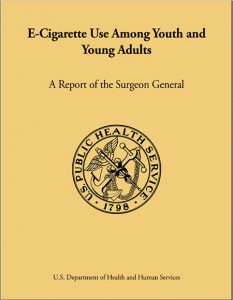Ribisl co-authors Surgeon General’s report on e-cigarette use by youth and young adults
December 15, 2016
 Kurt Ribisl, PhD, professor of health behavior at UNC Gillings School of Global Public Health and program leader for cancer prevention and control at UNC Lineberger Comprehensive Cancer Center, is a co-author of the 2016 Surgeon General’s report, “E-cigarette Use Among Youth and Young Adults.”
Kurt Ribisl, PhD, professor of health behavior at UNC Gillings School of Global Public Health and program leader for cancer prevention and control at UNC Lineberger Comprehensive Cancer Center, is a co-author of the 2016 Surgeon General’s report, “E-cigarette Use Among Youth and Young Adults.”
The report, published by the United States Department of Health and Human Services’ Office on Smoking and Health, part of the Centers for Disease Control and Prevention’s National Center for Chronic Disease Prevention and Health Promotion, outlines the history and epidemiology of tobacco use in the U.S., summarizes current research on the rise of e-cigarette use among young people, and makes a call to action to better regulate e-cigarettes and educate young people about health risks related to e-cigarette use.
Although cigarette smoking among people ages 18 and younger has dropped over the last decade, there has been a dramatic rise (900 percent among high school students between 2011 and 2015) in the use of e-cigarettes, devices that deliver nicotine, flavorings and other additives through an inhaled aerosol.
“The report highlights what we know and do not know about e-cigarettes,” writes Surgeon General Vivek H. Murthy, MD, MBA. “The health effects…of heated and aerosolized…solvents, flavorants and toxicants are not completely understood. However, we know that aerosol from e-cigarettes is not harmless. [We know] that the brains of young adults are more vulnerable to the negative consequences of nicotine exposure, including addiction, reduced impulse control, deficits in attention and cognition, and mood disorders … Fetal exposure to nicotine during pregnancy can result in multiple adverse consequences, including sudden infant death syndrome … Ingestion of e-cigarette liquids also can cause acute toxicity and death.”
Among the report’s conclusions are:
- E-cigarette use among youth and young adults is a public health concern. In 2014, use by people ages 18 to 24 surpassed that of adults ages 25 and older.
- E-cigarettes are the most commonly used nicotine-delivery product, and their use is strongly associated with the use of tobacco products, including cigarettes.
- Any use of products containing nicotine poses danger to young people, pregnant women and fetuses.
- E-cigarette aerosol is not harmless. Nicotine exposure during adolescence can cause addiction and can harm the developing brain.
- E-cigarettes are marketed by promoting flavors and using a wide variety of media channels and approaches, techniques used previously for marketing tobacco products to young people.
- Action can and must be taken at the local, state and national levels to address e-cigarette use by young people. Actions may include incorporating e-cigarette use into smokefree policies; using taxes and licensure to limit access; regulating marketing targeted at youth; and developing educational initiatives to make young people more aware of smoking risks.
Ribisl was one of 23 contributing researchers and authors from across the U.S.
The Surgeon General’s report is available online.
Free help to quit smoking is available at 1-800-QUIT-NOW or smokefree.gov.
Share
Gillings School of Global Public Health contact: David Pesci, director of communications, (919) 962-2600 or dpesci@unc.edu

